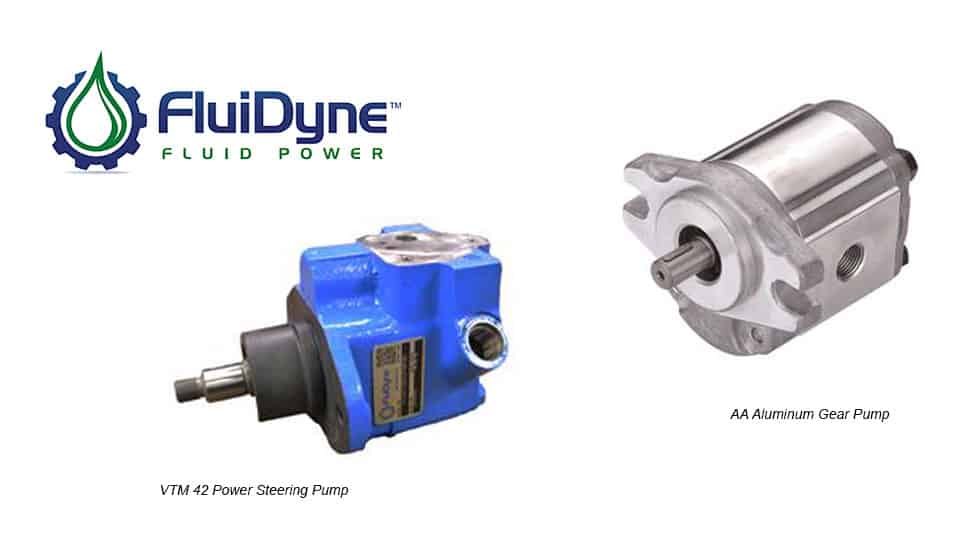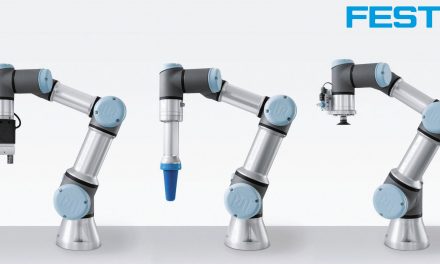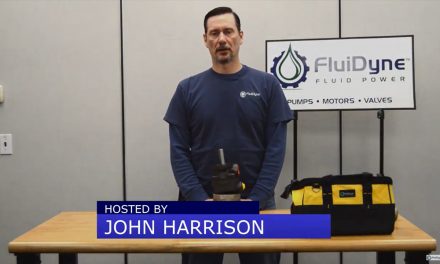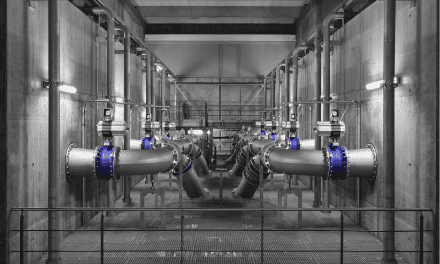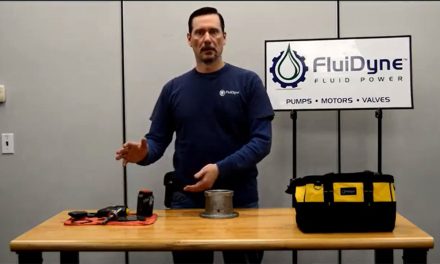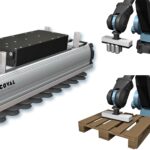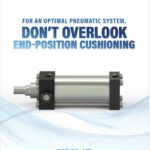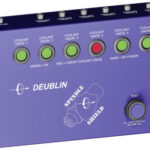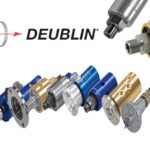A white paper written by FluiDyne Fluid Power, Scott Mason, Certified Fluid Power Specialist
How Often Should You Replace Your Pump?
A frequent question in the Fluid Power industry is, “when or how often should I replace my pump?” The truthful but unsatisfying answer is, “it depends”. It depends on a multitude of factors, operating conditions, age, duty cycle, and performance to name a few. There are, however, some key indicators that point to a pumps impending demise, that when detected early enough can mitigate the damages.
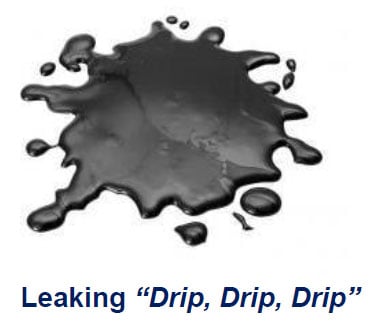 The most common form and most often overlooked sign of pump failure is the simple leak. There are two basic types of leaks, external and internal.
The most common form and most often overlooked sign of pump failure is the simple leak. There are two basic types of leaks, external and internal.
External Leakage is fairly easy to spot; fluid can be weeping or flowing to the outside of a pump and usually collects into a puddle. External leakage can be fairly easy to spot with a clean environment. However, poor housekeeping can make the small, telltale drip from a leaking seal very difficult to spot. When there are puddles and grime everywhere, a small leak may go unnoticed, until it becomes a flood.
Internal Leakage on the other hand is not going to be spotted visually. Fluid slipping (leaking) over vanes, or the rotating group of a worn pump, will produce heat. This inefficiency will not be seen visually but can be felt or measured in the form of system heat. All leakage, be it internal or external, compromises system performance in the form of flow. With less fluid/flow doing the work the cycle time/performance suffers from a slower response.
Performance “Timing is Everything”
Cycle time in a hydraulic system is a sure-fire way to reveal a declining system (pump) performance. There is a simple method for testing your system performance. This high tech method requires nothing more than a clear view of the system actuator and a watch with a second hand. While viewing the actuator, note the time for a complete cycle. Note the cycle time when a unit is new and you will have a baseline to compare with at a later date. (Tip: write the cycle time on the actuator, the reservoir for an industrial system or frame rail for a mobile application, you won’t have to search for it later). As cycle time begins to increase, internal fluid leakage is the likely culprit. Think a couple of seconds added to your cycle won’t matter? Just imagine a new cylinder that has a cycle time of 10 seconds to extend and retract. This same cylinder cycles once a minute, or 60 times in an hour, for two 8 hour shifts (960 times in a day). Now, add 5 seconds to the cycle time due to component wear. This is a total of 4800 seconds, or 80 extra minutes per day, waiting for a cylinder to extend and retract. Simply put this is 80 minutes worth of wasted dollars a day all because of a small internal leak. 80 minutes a day, times 5 days a week at 4 weeks a month, 12 months a year times $ lost labor cost per hour, well you get the picture pretty fast! A few minutes twice a month to check hydraulic cycle time is a small step that can lead to potentially huge savings.
Noise “Can’t You Hear Me Knocking?”
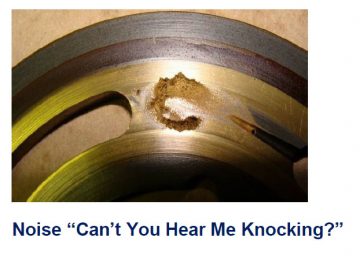 All hydraulic systems have their inherent noises, the whine of an electric motor, the revving of a truck motor, the sound of a piston pump at pressure turning 1750 RPM. Then there are the other odd sounds, such as the grinding noise or the dreaded knocking sound. These other sounds are a definite indicator that something is amiss. If you cannot have a conversation near a running hydraulic system without straining to be heard, there is an issue with this system.
All hydraulic systems have their inherent noises, the whine of an electric motor, the revving of a truck motor, the sound of a piston pump at pressure turning 1750 RPM. Then there are the other odd sounds, such as the grinding noise or the dreaded knocking sound. These other sounds are a definite indicator that something is amiss. If you cannot have a conversation near a running hydraulic system without straining to be heard, there is an issue with this system.
Most likely there is an air leak in the system and air is mixing with the hydraulic fluid (aeration). This causes the entrained air to implode while being compressed (cavitation) in the pump, leading to the banging noise. Cavitation is destructive to hydraulic systems in many ways. The imploding will cause metal surfaces to erode and pit, filling the system with metal contaminants. This entrained air will degrade system fluid to the point that it can fail to provide lubrication to the moving components, resulting in overheating and eventual system failure.
The most common point of entry for this air is at or near the pump’s suction port. Flange ports that aren’t tight, loose hose connections, or a cracked housing on the pump itself will all allow air into the system. Even a leaking shaft seal may have the ability to draw air into the system. Cloudy oil is usually an indicator of aeration.
Another source for cavitation is a restriction at the pump’s inlet, (think suction strainers and inlet hose). This restriction can cause the system fluid to actually vaporize as it enters the pump, essentially trying to pump vapor, which collapses under compression, destroying pump internals. All of this noise, banging, knocking, clanging, is your system talking and it’s telling you that something is wrong!
Heat “It’s Getting Hot in Here”
How hot is your hydraulic system? Can you safely hold your hand over the pump? It should be warm; it’s moving fluid and doing work. However, if your pump is so hot that you cannot briefly rest your hand on it, there is likely an issue.
Heat in a hydraulic system has many detrimental effects; the greatest is on the hydraulic oil itself. Oil should be maintained near 120°F for the best results, and never exceed 150°F. Oil that is heated above the 120°F mark will oxidize and begin to separate into acids and sludge, which will cause corrosion. The sludge will begin to block orifice pathways leading to more heat. This heat generation then leads a loss of viscosity, this lower viscosity will cause a greater slippage or internal leakage that creates more heat, it is a vicious cycle (not viscous).
We have covered that internal wear/leakage can develop heat; there are other areas as well, cavitation is one. When the air trapped in hydraulic fluid is compressed and implodes all of that energy has to go somewhere, it is turned into the form of heat and pumped into the rest of the system, only to end up in the reservoir. The reservoir is designed to do more than just hold fluid; it also functions as a heat exchanger by letting the oil cool and dissipate heat to the atmosphere through the walls and air circulation. A reservoir that is not at the correct fluid level may not allow the oil enough time to exchange this heat.
Some revealing signs that a hydraulic system is experiencing excessive heat are square o-rings. When you disassemble a pump exposed to high heat, frequently the seals for the body o-rings are no longer a round cross-section but are flat or “squared” from the heat. They essentially have been melted and reshaped. Discolored blue witness marks to internal pump components such as a cam ring or shaft indicate the presence of high heat.
All hydraulic systems generate some heat, just the resistance of the fluid flowing through the hose and tubing will raise temperatures, it’s the extreme greater than 180°F temperatures that are so lethal to system components.
Using Sense to Save Cents
When is the best time to replace or rebuild a pump? Baring total failure, nothing is going to answer that question better than a well managed preventative maintenance program and historical data. Nonetheless, a little observation using your senses can really be an excellent predictor of where your system is headed.
- Sight – How long is the cycle time and how does it compare to new? What is the fluid condition?
- Sound – How loud is your system, are there any abnormal sounds?
- Touch – How warm is the system running?
- Smell – Does the hydraulic fluid have a burnt order?
- Taste – Don’t even think about it!
Are the above red flags starting to pop up in your system? Is the cycle time starting to creep up? Then it may be time to start planning to replace or rebuild your pump. Do you have a spare unit in inventory? Now is the time to verify model codes and confirm that all system components are working properly. Order new components as needed, note if your system is at the stage that the pump needs to be replaced, then so do the filters! Do not install a new pump into a system with dirty oil and filters. Install the new unit into your system, after adjustment record the cycle time, and monitor periodically.
This paper does not intend to cover all potential causes of pump failure; they are many and varied. It assumes that mechanical issues such as; pump and prime mover alignment are correct, system pressure will be properly maintained, and the pump was filled with fluid prior to start up. This information is presented as a guideline to help diagnose impending pump issues.
FluiDyne Fluid Power strives to provide the highest quality pumps, motors, and valves available. All of our products new or rebuilt carry an 18 month warranty and are ready to ship the same day. Don’t’ believe us? Call our customer service team to find out.
Brought to you by FLUIDYNE, a partner of DIRECTPNEUMATICS.COM

